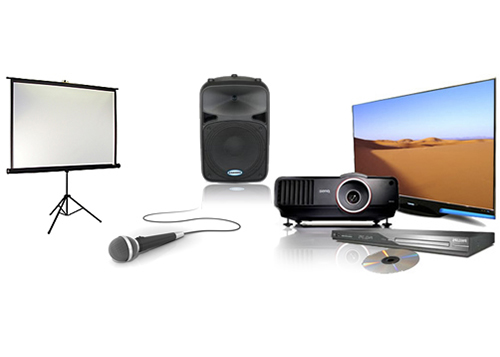Recognizing the Addition of Audio Visual Innovation in Today's Educational Environments
The assimilation of audio-visual modern technology in instructional setups has transformed the mentor and learning procedure. Educators now have access to devices that deal with numerous finding out styles, boosting trainee interaction and collaboration. Nevertheless, the consolidation of these modern technologies offers both opportunities and challenges. Comprehending exactly how to efficiently execute these devices is necessary. What strategies can teachers utilize to make best use of the benefits of audio-visual modern technology in their class?
The Development of Audio-Visual Technology in Education
As instructional requirements developed over the decades, audio-visual modern technology went through significant makeovers that reshaped the learning setting. Initially, devices such as film projectors and slide shows were the key means of integrating aesthetic elements into class. These early technologies supplied educators with the ability to present details dynamically, yet they were limited in ease of access and interactivity.
With the arrival of videotape recorder in the 1970s, classrooms began to integrate taped lessons, widening the extent of academic sources. The intro of computers in the 1980s further changed this landscape, permitting the creation of multimedia discussions and interactive knowing experiences.
The surge of the web in the 1990s marked a turning point, making it possible for real-time accessibility to a wide range of audio-visual products. Today, electronic tools such as interactive white boards and on-line learning platforms proceed to boost the educational experience, promoting interaction and partnership among learners.
Benefits of Audio-Visual Tools for Diverse Knowing Styles
Audio-visual tools play a necessary duty in dealing with varied understanding designs by improving visual learning and enhancing auditory interaction. By integrating images, video clips, and noise, these technologies produce a more inclusive educational environment. This complex technique allows educators to resolve the different preferences and needs of pupils successfully.
Enhancing Visual Learning
Involvement in the knowing procedure is substantially improved via making use of audio-visual devices, dealing with various discovering styles. These tools, such as video clips, infographics, and interactive presentations, give visual stimulations that aid understanding and retention. Aesthetic learners, in particular, gain from the incorporation of pictures and computer animations, which can simplify intricate concepts and enhance understanding. Additionally, audio-visual sources can show real-world applications, making finding out more appropriate and interesting. By incorporating shade, movement, and audio, educators can produce a dynamic understanding environment that catches trainees' interest and promotes much deeper cognitive links. Ultimately, the strategic use audio-visual technology not just sustains aesthetic knowing but likewise improves the overall academic experience for varied students.
Improving Auditory Involvement
A significant advantage of integrating audio-visual tools in education and learning is their capability to boost auditory interaction among trainees. These tools, which include multimedia presentations, podcasts, and interactive sound aspects, satisfy different learning styles, specifically profiting acoustic students (audio visual charlotte nc). By integrating sound and narration, instructors can produce immersive experiences that capture students' interest and strengthen understanding. This involvement is essential, as it promotes a much deeper understanding of the material and promotes retention. Furthermore, audio-visual devices can promote joint knowing settings, motivating trainees to take part in conversations and share their understandings. Inevitably, the unification of audio-visual innovation not only supports acoustic engagement but likewise enriches the general academic experience, making discovering more dynamic and reliable for all pupils
Enhancing Involvement Via Interactive Understanding

In addition, gamification elements, such as tests and simulations, can enhance inspiration and retention, making discovering more enjoyable and efficient. These approaches not just stimulate cognitive involvement however additionally satisfy varied knowing designs, guaranteeing that all pupils can take part meaningfully. Because of this, interactive discovering settings promote a feeling of community and belonging, inevitably leading to boosted scholastic end results. Through the combination of audio aesthetic modern technology, educators can transform standard classrooms into lively areas where pupils grow and proactively form their educational journeys.
Linking Theory and Experiment Multimedia Resources
Multimedia sources work as a critical link between theoretical ideas and sensible application in educational setups. By boosting involvement, promoting collaborative knowing experiences, and supporting diverse understanding designs, these tools produce a much more comprehensive and dynamic understanding setting - audio visual charlotte nc. This approach not only promotes deeper understanding however likewise prepares trainees for real-world obstacles

Enhancing Involvement Through Multimedia
Engagement in educational setups greatly raises when teachers include multimedia resources right into their mentor techniques. Using videos, podcasts, and interactive discussions improves the learning experience, permitting trainees to get in touch with the material on multiple levels. Multimedia sources provide to different learning designs, giving aesthetic, auditory, and kinesthetic stimuli that can hold trainees' attention better than typical lecture techniques. Additionally, these sources can simplify intricate principles, making them a lot more easily accessible and memorable. By incorporating multimedia, teachers can create a vibrant classroom environment that promotes curiosity and encourages learners. Inevitably, the tactical use audio-visual innovation offers to bridge the void between theoretical expertise and practical application, enhancing the academic experience for both instructors and trainees.
Promoting Collaborative Knowing Knowledge
Countless studies suggest that joint knowing experiences markedly enhance trainee results when integrated with multimedia resources. Multimedia devices facilitate interaction among trainees, permitting them to participate in analytical and vital assuming jointly. By utilizing video clip conferencing, joint platforms, and interactive presentations, educators create atmospheres helpful to synergy and shared learning. These modern technologies enable students to communicate their ideas successfully and obtain immediate comments, cultivating a deeper understanding of the subject matter. On top of that, multimedia sources can present complex concepts in more digestible layouts, promoting conversation and cooperation. Therefore, the combination of collaborative understanding and audio-visual modern technology not just enriches the educational experience yet also prepares students for real-world teamwork characteristics, stressing the relevance of cooperation and collective knowledge building.
Sustaining Diverse Discovering Styles
While standard mentor techniques commonly satisfy a restricted variety of learning choices, the combination of audio-visual innovation provides a more inclusive strategy to education and learning. By using multimedia sources such as videos, interactive simulations, and digital presentations, educators can resolve different learning designs, including aesthetic, auditory, and kinesthetic. This adaptability permits distinguished guideline, allowing students to engage with web content in manner ins which resonate with their specific preferences. In addition, audio-visual devices can assist in deeper understanding by offering several representations of complicated principles. Because of this, students that might deal with standard techniques can locate alternate paths to success, cultivating a much more fair learning setting that supports scholastic accomplishment for all learners.
Challenges in Applying Audio-Visual Technology
Although audio-visual modern technology holds excellent promise for improving instructional experiences, its implementation frequently runs into significant difficulties. One primary worry is the economic worry associated with buying and keeping such tools, which can strain budget plans, specifically in underfunded institutions. Furthermore, insufficient training for educators can prevent effective integration, leaving them ill-prepared to make use of the technology fully. Technical issues, such as software breakdowns and compatibility issues, might also interrupt lessons and irritate both educators and pupils. Differing degrees of student access to technology outside the classroom can develop differences in finding out possibilities. Ultimately, the potential for over-reliance on technology may detract from crucial mentor techniques, ultimately restricting the instructional experience. Resolving these difficulties requires an extensive approach, including appropriate funding, professional growth, and equitable access to sources, to assure that audio-visual technology can be leveraged properly in today's instructional settings.
Ideal Practices for Integrating Modern Technology in the Classroom

In addition, fostering an interactive environment via collaborative tools motivates student involvement and involvement. Making use of varied audio-visual sources accommodates numerous learning styles, suiting visual, auditory, and kinesthetic learners. Consistently reviewing the impact of technology on trainee understanding assists educators fine-tune their strategies and adjust to transforming demands. Including pupils in the option of modern technology advertises ownership and motivation. By sticking to these ideal methods, educators can produce a dynamic classroom atmosphere that efficiently integrates modern technology and improves the academic experience for all students.
The Future of Audio-Visual Modern Technology in Education And Learning
As classrooms increasingly embrace technology, the landscape of audio-visual devices in education continues to evolve (audio visual charlotte nc). Future advancements are anticipated to concentrate on greater interactivity and customization, allowing instructors to tailor learning experiences to private pupil requirements. Developments such as augmented fact (AR) and online reality (VIRTUAL REALITY) will likely supply immersive learning atmospheres, enhancing pupil engagement and understanding
Man-made knowledge (AI) is poised to play a considerable duty in audio-visual innovation by providing real-time responses and adaptive understanding pathways. This assimilation may aid educators determine and address pupil challenges more effectively. Cloud-based systems will certainly facilitate much easier accessibility to resources and collaboration among pupils and teachers, no matter of area.
In enhancement to these technological advances, specialist growth for educators will be essential, guaranteeing they are equipped to utilize these devices effectively. In general, the future of audio-visual innovation in education and learning assures to create more vibrant, comprehensive, and impactful knowing experiences.
Often Asked Concerns
How Can Teachers Select the Right Audio-Visual Devices for Their Class?
Choosing suitable audio-visual tools needs teachers to evaluate their instructional objectives, think about pupil requirements, assess readily available technology, and look for referrals from peers or professionals, making sure devices efficiently improve learning and interaction within their certain classroom setting.
What Spending plan Considerations Are There for Applying Audio-Visual Innovation?
Spending plan factors to consider for executing audio-visual modern technology include initial purchase costs, upkeep expenditures, training for team, and potential software program licensing fees. Furthermore, lasting investment in updates and replacements ought to also be factored right into economic preparation.
Exist Particular Training Resources for Educators on Audio-Visual Devices?
Numerous establishments use training resources for teachers on audio-visual devices, including on the internet programs, workshops, and instructional overviews. These resources intend to boost educators' abilities and confidence in effectively integrating modern technology into their training practices.
Exactly how Do We Gauge the Efficiency of Audio-Visual Modern Technology in Knowing?
Gauging the performance of audio-visual modern technology in here discovering entails examining pupil interaction, understanding, retention rates, and general scholastic performance. Studies, assessments, and observational studies can give important insights right into its effect on educational results.
What Prevail Misconceptions Regarding Audio-Visual Innovation in Education And Learning?
Usual false impressions regarding audio-visual innovation in education and learning consist of the idea that it guarantees interaction and discovering results, along with the assumption that all students benefit similarly, ignoring specific understanding preferences and needs.